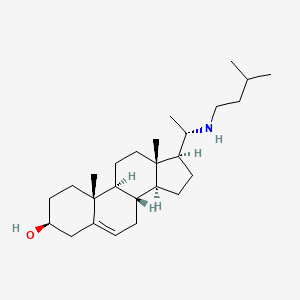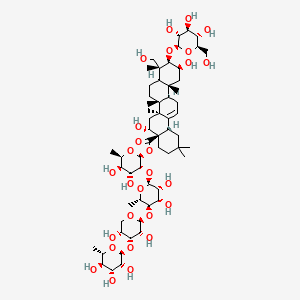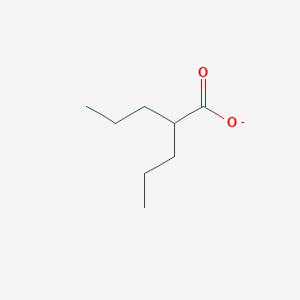
2-propylpentanoate
Overview
Description
It is primarily used as a medication to treat epilepsy, bipolar disorder, and to prevent migraine headaches . 2-propylpentanoate was first synthesized in 1882 by Burton, but its anticonvulsant properties were not discovered until 1962 by Pierre Eymard . It is available in various forms, including valproic acid, sodium valproate, and valproate semisodium .
Scientific Research Applications
2-propylpentanoate has a wide range of scientific research applications:
Chemistry: Used as a reagent in organic synthesis and as a solvent for various chemical reactions.
Medicine: Widely used as an anticonvulsant and mood stabilizer.
Industry: Used in the production of pharmaceuticals and as a stabilizer in certain formulations.
Preparation Methods
Synthetic Routes and Reaction Conditions
2-propylpentanoate can be synthesized through several methods. One common method involves the reaction of valeric acid with sodium hydroxide to produce sodium valproate. Another method involves the esterification of valeric acid with ethanol, followed by hydrolysis to yield valproic acid .
Industrial Production Methods
In industrial settings, valproate is often produced through the oxidation of 2-propylpentanol. This process involves the use of oxidizing agents such as potassium permanganate or chromium trioxide under controlled conditions to yield valproic acid .
Chemical Reactions Analysis
Types of Reactions
2-propylpentanoate undergoes various chemical reactions, including:
Oxidation: this compound can be oxidized to produce valeric acid.
Reduction: It can be reduced to produce 2-propylpentanol.
Substitution: This compound can undergo substitution reactions to form various derivatives.
Common Reagents and Conditions
Oxidation: Potassium permanganate or chromium trioxide in acidic conditions.
Reduction: Lithium aluminum hydride in anhydrous ether.
Substitution: Halogenating agents such as thionyl chloride or phosphorus tribromide.
Major Products Formed
Oxidation: Valeric acid.
Reduction: 2-propylpentanol.
Substitution: Halogenated derivatives of valproate.
Mechanism of Action
2-propylpentanoate exerts its effects through multiple mechanisms:
GABAergic System: Increases the levels of gamma-aminobutyric acid (GABA) in the brain, enhancing inhibitory neurotransmission.
Sodium Channels: Blocks voltage-gated sodium channels, reducing neuronal excitability.
Histone Deacetylase Inhibition: Inhibits histone deacetylases, leading to changes in gene expression and chromatin structure.
Other Pathways: Affects the Wnt/β-catenin and ERK signaling pathways, and interferes with inositol and arachidonate metabolism.
Comparison with Similar Compounds
2-propylpentanoate is unique compared to other anticonvulsants due to its broad spectrum of activity and multiple mechanisms of action. Similar compounds include:
Sodium Butyrate: Another histone deacetylase inhibitor with similar effects on gene expression.
Trichostatin A: A potent histone deacetylase inhibitor used in research.
Divalproex Sodium: A compound of sodium valproate and valproic acid that dissociates to valproate in the gastrointestinal tract.
This compound’s ability to modulate multiple pathways and its broad therapeutic applications make it a valuable compound in both clinical and research settings.
Properties
Molecular Formula |
C8H15O2- |
|---|---|
Molecular Weight |
143.2 g/mol |
IUPAC Name |
2-propylpentanoate |
InChI |
InChI=1S/C8H16O2/c1-3-5-7(6-4-2)8(9)10/h7H,3-6H2,1-2H3,(H,9,10)/p-1 |
InChI Key |
NIJJYAXOARWZEE-UHFFFAOYSA-M |
SMILES |
CCCC(CCC)C(=O)[O-] |
Canonical SMILES |
CCCC(CCC)C(=O)[O-] |
Synonyms |
2 Propylpentanoic Acid 2-Propylpentanoic Acid Calcium Valproate Convulsofin Depakene Depakine Depakote Dipropyl Acetate Divalproex Divalproex Sodium Ergenyl Magnesium Valproate Propylisopropylacetic Acid Semisodium Valproate Sodium Valproate Valproate Valproate Calcium Valproate Sodium Valproic Acid Valproic Acid, Sodium Salt (2:1) Vupral |
Origin of Product |
United States |
Synthesis routes and methods I
Procedure details











Synthesis routes and methods II
Procedure details














Retrosynthesis Analysis
AI-Powered Synthesis Planning: Our tool employs the Template_relevance Pistachio, Template_relevance Bkms_metabolic, Template_relevance Pistachio_ringbreaker, Template_relevance Reaxys, Template_relevance Reaxys_biocatalysis model, leveraging a vast database of chemical reactions to predict feasible synthetic routes.
One-Step Synthesis Focus: Specifically designed for one-step synthesis, it provides concise and direct routes for your target compounds, streamlining the synthesis process.
Accurate Predictions: Utilizing the extensive PISTACHIO, BKMS_METABOLIC, PISTACHIO_RINGBREAKER, REAXYS, REAXYS_BIOCATALYSIS database, our tool offers high-accuracy predictions, reflecting the latest in chemical research and data.
Strategy Settings
| Precursor scoring | Relevance Heuristic |
|---|---|
| Min. plausibility | 0.01 |
| Model | Template_relevance |
| Template Set | Pistachio/Bkms_metabolic/Pistachio_ringbreaker/Reaxys/Reaxys_biocatalysis |
| Top-N result to add to graph | 6 |
Feasible Synthetic Routes
Disclaimer and Information on In-Vitro Research Products
Please be aware that all articles and product information presented on BenchChem are intended solely for informational purposes. The products available for purchase on BenchChem are specifically designed for in-vitro studies, which are conducted outside of living organisms. In-vitro studies, derived from the Latin term "in glass," involve experiments performed in controlled laboratory settings using cells or tissues. It is important to note that these products are not categorized as medicines or drugs, and they have not received approval from the FDA for the prevention, treatment, or cure of any medical condition, ailment, or disease. We must emphasize that any form of bodily introduction of these products into humans or animals is strictly prohibited by law. It is essential to adhere to these guidelines to ensure compliance with legal and ethical standards in research and experimentation.
![1-[2-(5-chloro-2-methyl-1H-indol-3-yl)ethyl]-3-ethyl-1-(2-furanylmethyl)thiourea](/img/structure/B1229082.png)
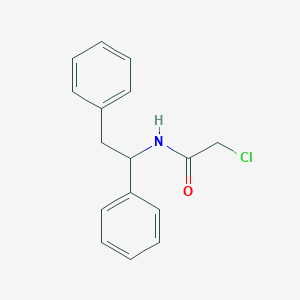
![3-Methyl-1-[1,3,7,9-tetrahydroxy-2,8-dimethyl-6-(3-methyl-1-oxobutyl)-4-dibenzofuranyl]-1-butanone](/img/structure/B1229091.png)
![[7-(2-methylbut-2-enoyloxy)-5,6,7,8-tetrahydro-3H-pyrrolizin-1-yl]methyl 2-hydroxy-2-(1-hydroxyethyl)-3-methylbutanoate](/img/structure/B1229092.png)
![4-[4-[(5-chloro-2-hydroxyphenyl)-oxomethyl]-1-pyrazolyl]-N-(4-methoxyphenyl)-3-nitrobenzenesulfonamide](/img/structure/B1229093.png)
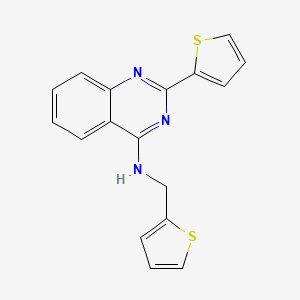


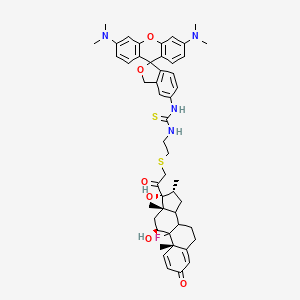
![4-[(E)-2-nitro-2-phenyl-1-[4-(2-pyrrolidin-1-ylethoxy)phenyl]ethenyl]phenol](/img/structure/B1229100.png)

